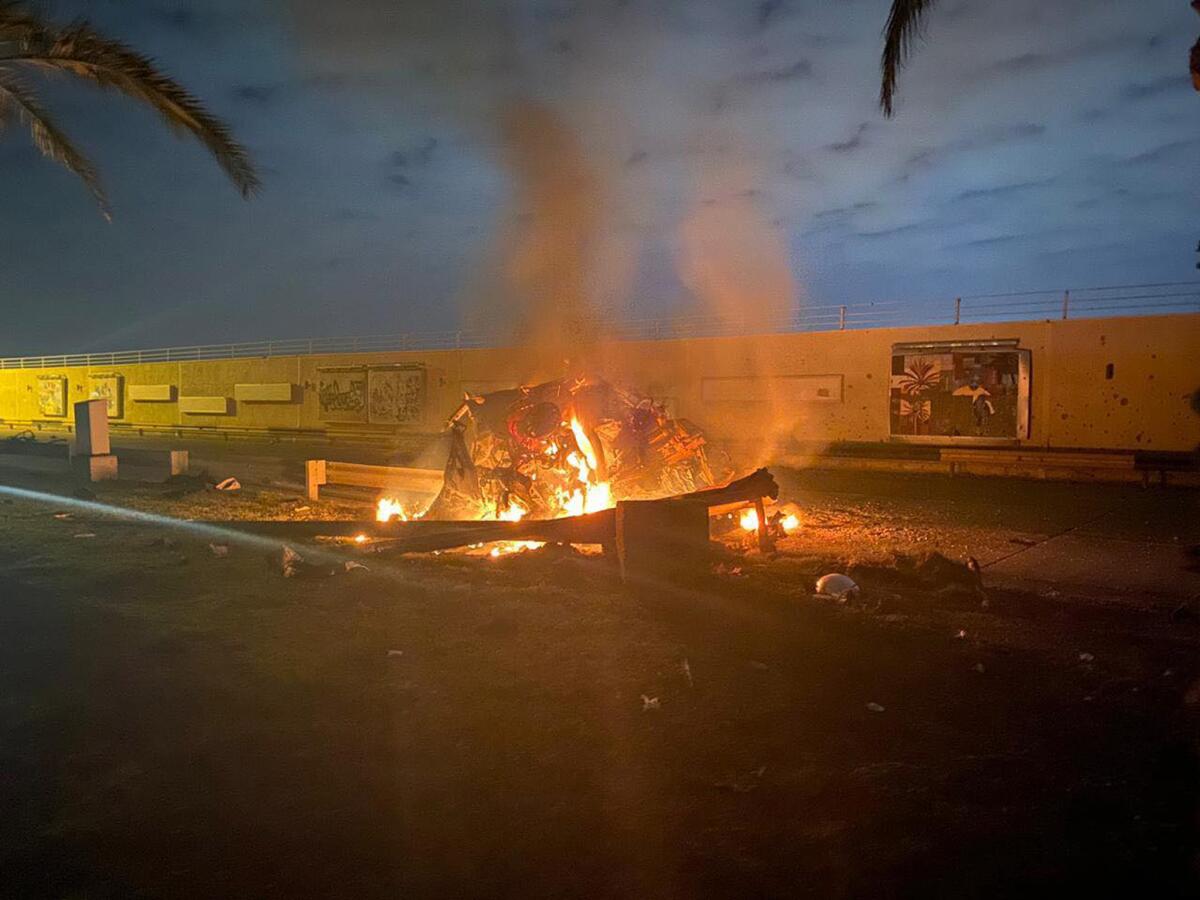Column: Trump’s Orwellian doublespeak on Iran

- Share via
WASHINGTON — The U.S. missile strike that killed Iranian Quds Force leader Qassem Suleimani was a stunning escalation of the conflict between the United States and Iran — an act of open war in a struggle that has been carried out in the shadows for decades.
Yet President Trump and his aides oddly called the airstrike a “deescalation,” as if it were a step toward peace.
“We took action last night to stop a war. We did not take action to start a war,” the president told supporters Friday.
It sounds like Orwellian doublespeak — an attempt to deny that killing a senior Iranian official ratcheted up hostilities by claiming the opposite.
Trump aides offered a convoluted explanation: Because Suleimani was working on plots against the United States, they said, killing him would impede those attacks — and thus “deescalate” the conflict, at least temporarily.
But that’s not deescalation; it’s preemption.
Still, there’s one way the term “deescalation” does apply. Trump and his aides appear to be using a tactic borrowed from nuclear weapons strategy — a gambit called “escalate to deescalate.”
The idea is that if you shock your adversaries with a sudden, violent attack, they may back down from action you want to deter.
But it’s a high-risk gamble. If the other side backs down, you win. If the other side retaliates and unleashes another round of escalation, the conflict can spiral out of control.
In nuclear strategy, both the United States and Russia have decided that “escalate to deescalate” — launching a small nuclear attack to deter a larger one — is a dangerous idea, because a miscalculation could be catastrophic.
A miscalculation with Iran could be catastrophic too, if it leads to a wider war.
Trump has used “escalate to deescalate” before, in his confrontation with North Korea.
In 2017, he was determined to stop North Korea from expanding its arsenal of nuclear weapons.
If Kim Jong Un continued threatening the United States, Trump warned, he would face “fire and fury ... the likes of which this world has never seen before.”
It looked and sounded like a cycle of escalation that could lead to nuclear war.
As tensions spiked, Kim proposed a summit meeting with Trump and announced a suspension of nuclear tests as a sign of goodwill. The two leaders met in Singapore and agreed to work toward “denuclearization on the Korean Peninsula.”
Two years later, the process appears stalemated; North Korea is still building nuclear weapons and missiles, and Kim made new threats last week. So Trump’s main objective hasn’t been met — but the level of tension is lower.
A diplomatic opening was possible because there was an offramp: Trump halted joint military exercises with South Korea and offered Kim reduced economic sanctions in return for clear moves toward denuclearization.
The process hasn’t succeeded, but at least the two sides are talking.
The Trump administration has offered no such offramp to Iran — unless you count the long list of demands Secretary of State Michael R. Pompeo has made of Tehran, ranging from an end to nuclear and missile development to wholesale changes in Iranian foreign and domestic policy.
The Trump administration has frequently offered to open talks with Iran, and it renewed those offers on Friday. But Trump has never offered Tehran anything as appealing as the menu he put before Kim.
Instead, Pompeo and other U.S. officials have often used language that sounds to Iranians as if the Trump administration is seeking regime change in Tehran.
And there’s an emotional element: Iran’s supreme leader, Ayatollah Ali Khamenei, has promised to seek revenge for the killing of his most important military official.
All those factors make it likely that we will see retaliation from Iran — and escalation instead of deescalation.
Iran’s retaliation could include attacks on oil refineries or tankers, or other U.S. interests by proxy forces in other countries. It could be a covert attack on an American general or other senior official in the Middle East. It could involve cyberattacks on U.S. financial institutions or other infrastructure.
But it’s almost certain to include a form of what might be called “strategic retaliation”: a carefully planned campaign, in the wake of Suleimani’s killing, to persuade Iraq’s parliament to expel U.S. forces from their country. Many Iraqis are outraged that the U.S. killed a senior Iranian official on their soil.
They could force the U.S. Embassy in Baghdad to close, a humiliating setback for the United States — especially given the immense U.S. sacrifice in lives and dollars in Iraq since 2003. Worse, it would make Iraq a virtual satellite of Iran — a huge strategic win for Tehran.
It would also illustrate the biggest mismatch between the United States and Iran: We have more money and more military power — but they appear to have a clearer strategy and more patience.
Trump and Pompeo have defined their policy toward Iran as “maximum pressure.” But without a clear goal and a plan to achieve it, that isn’t a strategy; it’s only a tactic.
The president’s goal, he says, is to get the United States out of the Middle East. The targeted killing of Suleimani risks pulling us deeper in.
More to Read
Get the L.A. Times Politics newsletter
Deeply reported insights into legislation, politics and policy from Sacramento, Washington and beyond. In your inbox three times per week.
You may occasionally receive promotional content from the Los Angeles Times.











